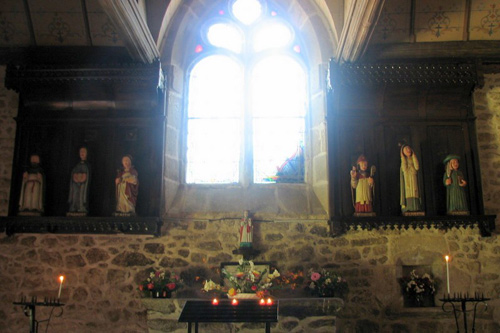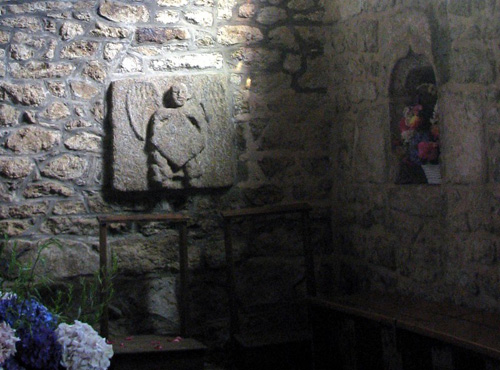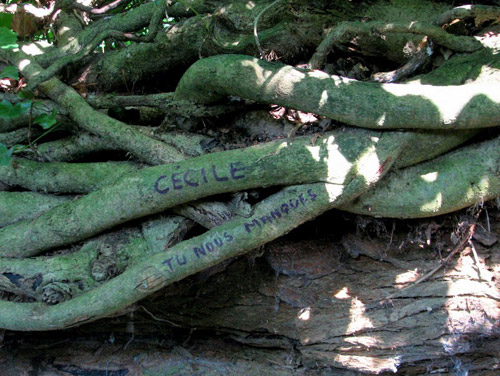The Seven Healing Saints
by Lucy Kempton
These photos were taken at the Chapel of Notre Dame du Hault, in Trédaniel, Côtes d’Armor, Brittany. It is the home of “Les Sept Saints Guéurisseurs,” the Seven Healing Saints, polychrome wood sculptures of uncertain age and provenance, each invested with the power to relieve certain afflictions. (Click on the photos to see larger versions.)
The Saints are St Houarniaule (or Hervé), St Mamert, St Méen, Ste Eugenie, St Lubin, St Livertin, and St Hubert. They were called on to cure a range of common maladies, such as migraines, eye troubles, rheumatism, but also mental and psychological problems; blind St Houarniaule who traditionally kept a dog or perhaps a wolf who ate the dog and was commanded by the saint to take its place, on a leash, was invoked to help with fear and ‘angoisse,’ anxiety, to master the wolf in a more figurative sense. St Hubert helped with dog-bites and rabies, ‘la rage,’ so by extension with rage and fear, the connection between fear and anger preempting modern psychological understanding. Ste Eugenie is the only woman, but wasn’t always; she was a feminised and Catholicised development of St Tujan, or Ujan, a much older, more indigenous saint, who was possibly in turn a Christianised version of a pre-Roman Celtic sun-deity.
St Mamert looked after intestinal troubles, including colicky babies. His intestines are exposed, open, and he holds them tenderly, a rather pretty pink coil of gut, between his two hands.
For a long time people brought gifts and offerings, oblations, for the Saints’ favours, either to propitiate or to thank them. They gave money, but also things like linen, hemp, butter, honey and beeswax, even piglets. The revenues from the chapel were enormous for such a small, out-of-the-way place. But by the end of the 19th century people began to offer other kinds of votives, these little plaques, mostly marble with engraved gilded lettering. They are in thanks for services rendered, and mostly simply say ‘Merci,’ Thank you, one or two are in English, some quite recent. (Many are also to Notre Dame to whom the Chapel is dedicated) The effect of the same word in different variations over and over in the gloom and candlelight is rather hypnotic.
Things have always made their way to the chapel, been sheltered by or given to it; the Saints’ statues were not all always there, some were probably brought from another religious foundation, a leper hospital, at about the time of the Revolution. This relief carving is an enigma, was perhaps brought here in the mid-20th century during one of the chapel’s periods of restoration from another demolished church or chapel. I always think of it as the angel with the book, but elsewhere the object is described as a blank escutcheon, a heraldic support for words or symbols. Book or shield, there is a feeling that the angel is bringing something of importance that should tell us something, but it can’t be read.
Unfortunately, what drew wealth of course drew thieves, and the chapel was not infrequently robbed throughout its history. Then in the 1980s the Saints themselves were stolen. They were replaced by plaster copies, which were stolen again in the last few years. The statues in these photos are very new replicas of the originals, that have recently been installed.
They are faithful and sympathetic copies, the scale and forms and colours are all as they should be. But the idea of replacing the Saints is problematical; its difficult to grasp how practical and concrete the kind of faith they were part of was. They weren’t just representations of spiritual power, the power was the object. We see them as curious works of art, which might or might not house a spiritual reality, but that’s not quite the point. The spiritual and material reality used to be one and the same. So making new ones to replace the old shouldn’t work.
Unless the power is within the place, rather than its furniture and artifacts. This has always been a sacred place, a place of healing; the chapel and the Saints are quite recent emanations of this. If you walk west from the chapel, past some prehistoric standing stones, into a wooded ravine, you’ll come to the holy well. In mediaeval times it was dedicated to St Tujan, and has been a sacred place probably since the bronze age; Gallo-Roman remains have certainly been found there. People throw the age-old votive offerings of coins into the well. There is a stone cross and other stone artefacts from who know where set up here. A fallen tree covered in ivy forms an arch in front of it. On the ivy stems someone has inscribed the words ‘Cécile tu nous manques’ — ‘Cécile we miss you.’
Who knows who Cecile is or was and why she is missed, but someone brought their sadness, their angoisse to this particular place of power and left it as an offering in these words, a poignant counterpoint to the marble plaques of gratitude.
With thanks to Bertrand L’Hôtellier for help with the research on the chapel of Notre Dame du Hault.
Lucy Kempton is British, living in Brittany with husband and dog, and sometimes teaching English. She blogs at box elder — subtitled “meanderings of a displaced dilettante” — and the microblog Out with Mol. She is currently engaged in a call-and-response-style, online collaboration with British blogger (and qarrtsiluni author) Joe Hyam called Questions. She co-edited qarrtsiluni’s Water issue with Katherine Durham Oldmixon.





Oh! I don’t even know where to start – the wall of thanks, the message on the roots – I need to come back to this when I am less rushed. Thank you for sharing these.
Fascinating! I love the slow-mo historical view: the melting faces of mutating saints, migratory objects of worship, the transmutation of oblatory piglet into decorous metal merci. With all this movement of the thing addressed, it sure sounds like the prayers themselves always were the true source of the power. Self-sustaining: like currencies no longer even nominally backed by gold.
Uh-oh.
I must complain, however, that the photographs are entirely too evocative. I happily would nick at least St. Mamert myself. Thank you so much, Lucy.
This is simply amazing. I keep coming here…reading, examining. Thank you so much!
Many thanks for these thoughtful and appreciative responses. It is a place that has interested me more and more over time, and it’s good to be able to share my impressions of it here.
Marvelous- all the more so because it reminds me of Guatemala–
I had absolutely no idea that Saint Hervé is also known as Houarniaule! His is a story that’s long intrigued me, and so I thank you for the extra snippet of information. Your piece on the seven healing saints is lovely Lucy. Right up my street. I shall be returning to study it at length.
Saints would not normally stop me in my tracks, but these pictures and the accompanying text are absolutely fascinating.
I knew Hervé through Clive, so that was especially interesting.
The business about new statues is curious. If one looks at it in New Testament terms, perhaps then “a new creation” where the “old is gone” and “the new has come” is not so bad a thing–that is, the new creation is actually a transformation of the old. Or perhaps one could think about it in death and resurrection terms, where one dies and is later given back one’s life…
I like the angel and imagine that I shouldn’t really be able to read the message an angel brings!
Your wanderings are always pleasing, Lucy.